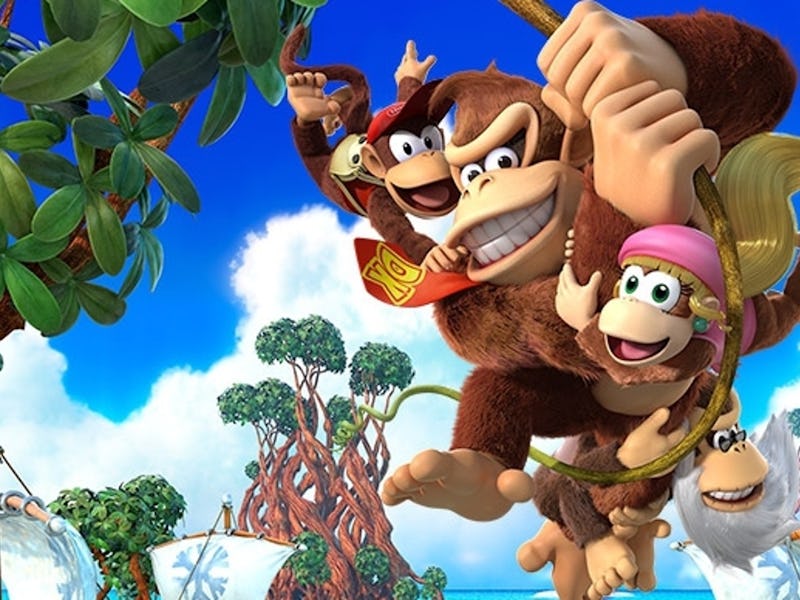10 Years Later, Nintendo’s Most Underrated Platformer Is Still A Step Above The Rest
Donkey Kong has had a long and fruitful career as a mainstay of Nintendo’s playable menagerie.

Donkey Kong has had a long and fruitful career as a mainstay of Nintendo’s playable menagerie. After early rounds of spaceships and generic cowboys, DK was the first named character of Nintendo’s modern era, one that now boasts the most valuable stable of I.P. this side of Disney. But it was his Donkey Kong Country games, first developed by Rare and then Retro Studios, that gave him a franchise of his own to run and jump through. Since the first in 1994, there have only been five games in the series (not counting Game Boy ports or remakes which included some unique content). The last, 2014’s Donkey Kong Country: Tropical Freeze, is inarguably the high point of the series, and is maybe the finest 2D platformer in that genre’s long and lustrous history.
Most platformers give you a small, lithe avatar to bounce around a collection of ever-harder levels. From Mario to Sonic, the independent icons of Super Meat Boy and Celeste to Prince of Persia, each offers control over a dexterous character with hyper maneuverability. Mario’s jump physics have been exhaustively broken down; Celeste’s mountain-climbing protagonist started life as a Pico-8 game, where pixel size required her to be miniature in stature. The eponymous Prince’s movement was an evolution of Jordan Mechner’s early work using rotoscope animation of his father in Karateka.
What makes the Donkey Kong Country games unique, and Tropical Freeze in particular, is the stature and weight of the titular character. Kong is big. He’s strong. He has gravity. It takes a while for him to moving. When he jumps you see him slapping the ground with his hands to help thrust his body up into the air. There’s a graceful effort behind his movements that gives his eventual momentum an earned quality; imagine a domino you had to push with all your might to topple. Compare this to Sonic, the “blue blur” who spins into a whirling dervish in microseconds, is to compare the majesty of a hulking Boeing 777x to a paper airplane caught in an updraft.
What makes the Donkey Kong Country games unique, and Tropical Freeze in particular, is the stature and weight of the titular character.
Everything in Tropical Freeze, from the level design to the soundtrack by composer David Wise, takes its cues from this idea: That DK is a giant, agile, beast. This is no plumber running around with a raccoon tail stitched to his overalls. This is a creature that, if you saw it barreling toward you in a jungle, you would run from in terror. He lopes across blazing grasslands. He plummets into water like a dropped boulder. When he pounds his fists onto the ground, he smashes wood and cracks cement; when he grabs onto a handle and pulls, it’s not like flipping a switch; you hold the button and you see Kong straining, only to finally succeed and unearth an entire tree from the earth.
Nowhere do you feel the satisfaction of DK’s heft better than in the mine cart levels, which have for some reason become synonymous with the big ape (who, for all I can tell, has never had to work underground). The runaway cart rolls with inexorable speed. When you jump and the cart lands back on the metal rails, sparks fly. My high school-level Physics knowledge tells me why: Force equals Mass times Acceleration. The bigger the mass, the greater the force.
The Donkey Kong Country games have always felt more of a piece than its predecessor Mario’s 2D adventures. Whereas Mario hops between arbitrary worlds based on this or that element, Donkey Kong’s country feels rooted in a wild animal’s habitat. The best levels in Tropical Freeze emphasize this. If it’s been a decade since you last booted it up, open your save file and jump to Grassland Groove, the first level in World 3’s Bright Savannah. The lowering sun floods your vision while Kong tramples across the screen, scored by percussion and chants redolent of The Lion King’s best moments. Baobab trees sway in time with the music. By the end, while you jump across a sequence of paper-mache giraffe heads and clutch at swaying, grass-covered platforms in the shape of serpent’s heads, you’ll realize Mario has rarely if ever touched this level of heightened yet organic design.
Tropical Freeze has maybe one of the Best Water Levels Ever, with the oft-cited “Irate Eight,” with its antagonist giant octopus and its chasing tentacles, heading up a list of watery wonderlands you actually look forward to swimming through instead of trying to get through as quick as you can.
It’s only a shame the original platform hero – Donkey having been the named, eponymous star of his own game in 1981, two years before Mario Bros. came out in the arcades and on Famicom in 1983 – has gotten short shrift compared to his shorter, more generic counterpart.
This year sees an addition to Super Nintendo World, featuring Donkey Kong and his iconic Mine Cart. That the big ape is Nintendo’s second installment in their major theme park initiative tells you how central he is to their mainstream popularity and the history of their modern era as a video game company. That they’ve let a decade pass since the last new star-turn for their first known character is a disappointment bordering on blasphemy. Rumor has it Nintendo may be remastering Tropical Freeze’s predecessor, Donkey Kong Country Returns, for release on the Switch system this year. Or even releasing a brand-new installment on the inevitable Switch successor. Now’s the perfect time to fire up the old Wii U (or grab the Switch port) and roll through some of the finest, funkiest 2D platforming levels ever created.